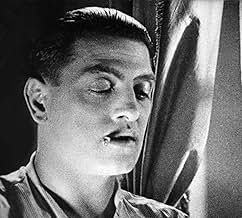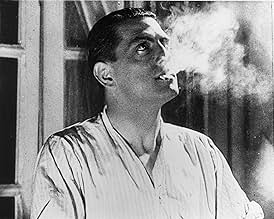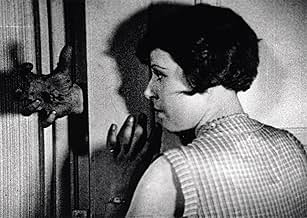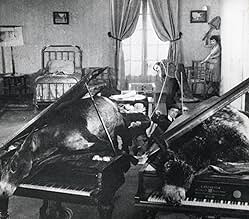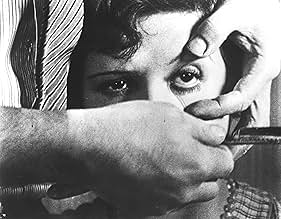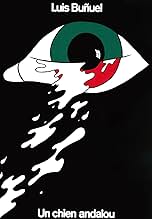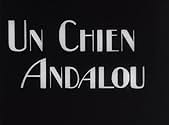VALUTAZIONE IMDb
7,6/10
55.729
LA TUA VALUTAZIONE
Luis Buñuel insieme a Salvador Dalí presentano un immaginario surreale e strano di sedici minuti.Luis Buñuel insieme a Salvador Dalí presentano un immaginario surreale e strano di sedici minuti.Luis Buñuel insieme a Salvador Dalí presentano un immaginario surreale e strano di sedici minuti.
Pierre Batcheff
- Man
- (as Pierre Batchef)
Simone Mareuil
- Young Girl
- (as Simonne Mareuil)
Luis Buñuel
- Man in Prologue
- (non citato nei titoli originali)
Pancho Cossío
- Stroller
- (non citato nei titoli originali)
Salvador Dalí
- Seminarist
- (non citato nei titoli originali)
Juan Esplandiu
- Stroller
- (non citato nei titoli originali)
Robert Hommet
- Young Man
- (non citato nei titoli originali)
Marval
- Seminarist
- (non citato nei titoli originali)
Fano Messan
- Hermaphrodite
- (non citato nei titoli originali)
Jaume Miravitlles
- Fat Seminarist
- (non citato nei titoli originali)
Recensioni in evidenza
"Sitting comfortably in a dark room, dazzled by the light and the movement which exert a quasi-hypnotic power... fascinated by the interest of human faces and the rapid changes of place, [a] cultivated individual placidly accepts the most appalling themes...and all this naturally sanctioned by habitual morality, government, and international censorship, religion, dominated by good taste and enlivened by white humor and other prosaic imperatives of reality." - Luis Bunuel
Un Chien Andalou exists to shock the viewer of this stupor that Bunuel elucidates above. Freudian dream imagery, amorphous space/time, and absurdist humor combine in this drawn out mating ritual between a confused cyclist and the female he pursues. May be the most inventive fifteen minutes of film anywhere.
Un Chien Andalou exists to shock the viewer of this stupor that Bunuel elucidates above. Freudian dream imagery, amorphous space/time, and absurdist humor combine in this drawn out mating ritual between a confused cyclist and the female he pursues. May be the most inventive fifteen minutes of film anywhere.
Even those who do not like Buñuel's "Un Chien Andalou" will probably never forget it once they see it. It's one of the weirder and more interesting films that you'll ever run across, and even aside from its significance, it would be worth seeing for the distinctive style and material.
It is also very well-crafted, despite its apparently chaotic narrative (or lack thereof). Even when it is impossible to attach meaning to some of the images, it seems clear that it has been filmed almost exactly as Buñuel and Dali intended. Even the music seems to have been chosen deliberately, and at times it complements the images surprisingly well.
While the exact meanings of many of the symbols are probably deliberately obscure, it strongly suggests some general themes such as desire, frustration, and the like. To attempt to analyze it carefully is almost certainly a mistake, and it is probably best taken as a dream or a dream-like series of events without the kinds of obvious connections that one might want to find.
Likewise, it's hard to determine just how good or how important it may be. The extreme disregard of cinema conventions is hard to evaluate now, in that the movie itself established some alternative conventions of a sort. The images themselves are often fascinating, sometimes unsettling or even off-putting, almost always interesting and suggestive.
Perhaps the one thing that can be said about such a movie without much risk of going astray is that almost anyone who has a real interest in cinema or cinema history will (or ought to) want to see "Un Chien Andalou" for himself or herself. Hearing it described by someone else really cannot adequately convey what it is like.
It is also very well-crafted, despite its apparently chaotic narrative (or lack thereof). Even when it is impossible to attach meaning to some of the images, it seems clear that it has been filmed almost exactly as Buñuel and Dali intended. Even the music seems to have been chosen deliberately, and at times it complements the images surprisingly well.
While the exact meanings of many of the symbols are probably deliberately obscure, it strongly suggests some general themes such as desire, frustration, and the like. To attempt to analyze it carefully is almost certainly a mistake, and it is probably best taken as a dream or a dream-like series of events without the kinds of obvious connections that one might want to find.
Likewise, it's hard to determine just how good or how important it may be. The extreme disregard of cinema conventions is hard to evaluate now, in that the movie itself established some alternative conventions of a sort. The images themselves are often fascinating, sometimes unsettling or even off-putting, almost always interesting and suggestive.
Perhaps the one thing that can be said about such a movie without much risk of going astray is that almost anyone who has a real interest in cinema or cinema history will (or ought to) want to see "Un Chien Andalou" for himself or herself. Hearing it described by someone else really cannot adequately convey what it is like.
Luis Buñuel, Calanda, in the province of Teruel in the south of the region called Aragón, a town itself afamed for the twenty-four hour non-stop drums (`la tamborada') in the streets played by hundreds of people together in Holy Week, as a young man fled to Paris with the intention of doing something great in this world. There he met Salvador Dalí who had done the same, leaving his native Catalonia in his mid twenties - some five years younger than Buñuel - with more or less the same ideas in his head.
These two young men, who in later years were to be known - even admired in some cases - as the most extravagant and flamboyant creators of art, were not alone. Pablo Picasso, not yet 50, had already been blazing the trail, to mention another Spaniard among those thronging the avant-garde Paris of the times. Claude Debussy and Maurice Ravel had led the impressionist movement in music for many years, and the `Imagiste' school in poetry was well under way. Anybody who was anybody in the artistic world flocked to Paris, and either made a hit and became someone eminent, or did not.
Cinema was a new art form still to be experimented with; no wonder, then, that these two men of evidently original ideas trying to burst out of them, had to do something so as to gatecrash into the gentry of the established circles of artistes and would-be artistes or hangers-on. The Buñuel-Dalí tandem knew they would produce something different; not necessarily to scandalize anyone, but more with the purpose of attracting attention, whether from intellectuals, artists or their entrepreneurs, or just newspaper editors. Simply following the logical sequence that words can be poetic and an image is worth a thousand words, and that poetry can be abstract, thus so can images, and if they move - better still.
Buñuel got a bit of money out of his mother's purse, and thus the two young men had finance to start on making an abstract poetic sequence which did not pretend to have any logical meaning of any kind. `Un Chien Andalou' was to exist in the same way that any later painting either by Picasso or by Dalí himself would exist without necessarily purporting to mean anything, either significant or insignificant, and without necessarily any implicit objective - far less objective - raison d'etre than simply existing in itself. Whether the result could or should be considered `art' in any quintessential sense is/was up to the pundits, pseudointellectuals, newspaper critics, or anybody else who thought he had any ideas on the matter. Buñuel himself says in his autobiography `My Last Breath' that he would have quite happily burnt the film, but that would not have made any difference anyway.
`Un Chien Andalou' was the only silent film he made; whether because of lack of funds or otherwise intentionally, is hard to say. `L'Age d'Or' one year later had sound; however I cannot help thinking that Buñuel and Dali wanted to make a silent film, which then does not explain why in the 1960s Buñuel chose to add music - Wagner interspersed with a tango, a blatently at-odds combination - which would seem to have been some attempt at being unfaithful to the original. But Buñuel was nothing if not a contradictory person, to say the least. But by the 1960s he was beginning to turn out his best repertoire - `Viridiana' (qv), `Tristana', etc - and maybe his sense of maturity reigned over his other feelings, compelling him to `up-date' the film for newer audiences, even though he might be accused of unloyalty.
But, how does one remain loyal to abstract concepts which defy rationality?
Thus `Un Chien Andalou' remains one of the most misunderstood pieces of art to have ever been made public, and is perhaps the most widely-known short film of all time.
These two young men, who in later years were to be known - even admired in some cases - as the most extravagant and flamboyant creators of art, were not alone. Pablo Picasso, not yet 50, had already been blazing the trail, to mention another Spaniard among those thronging the avant-garde Paris of the times. Claude Debussy and Maurice Ravel had led the impressionist movement in music for many years, and the `Imagiste' school in poetry was well under way. Anybody who was anybody in the artistic world flocked to Paris, and either made a hit and became someone eminent, or did not.
Cinema was a new art form still to be experimented with; no wonder, then, that these two men of evidently original ideas trying to burst out of them, had to do something so as to gatecrash into the gentry of the established circles of artistes and would-be artistes or hangers-on. The Buñuel-Dalí tandem knew they would produce something different; not necessarily to scandalize anyone, but more with the purpose of attracting attention, whether from intellectuals, artists or their entrepreneurs, or just newspaper editors. Simply following the logical sequence that words can be poetic and an image is worth a thousand words, and that poetry can be abstract, thus so can images, and if they move - better still.
Buñuel got a bit of money out of his mother's purse, and thus the two young men had finance to start on making an abstract poetic sequence which did not pretend to have any logical meaning of any kind. `Un Chien Andalou' was to exist in the same way that any later painting either by Picasso or by Dalí himself would exist without necessarily purporting to mean anything, either significant or insignificant, and without necessarily any implicit objective - far less objective - raison d'etre than simply existing in itself. Whether the result could or should be considered `art' in any quintessential sense is/was up to the pundits, pseudointellectuals, newspaper critics, or anybody else who thought he had any ideas on the matter. Buñuel himself says in his autobiography `My Last Breath' that he would have quite happily burnt the film, but that would not have made any difference anyway.
`Un Chien Andalou' was the only silent film he made; whether because of lack of funds or otherwise intentionally, is hard to say. `L'Age d'Or' one year later had sound; however I cannot help thinking that Buñuel and Dali wanted to make a silent film, which then does not explain why in the 1960s Buñuel chose to add music - Wagner interspersed with a tango, a blatently at-odds combination - which would seem to have been some attempt at being unfaithful to the original. But Buñuel was nothing if not a contradictory person, to say the least. But by the 1960s he was beginning to turn out his best repertoire - `Viridiana' (qv), `Tristana', etc - and maybe his sense of maturity reigned over his other feelings, compelling him to `up-date' the film for newer audiences, even though he might be accused of unloyalty.
But, how does one remain loyal to abstract concepts which defy rationality?
Thus `Un Chien Andalou' remains one of the most misunderstood pieces of art to have ever been made public, and is perhaps the most widely-known short film of all time.
Luis Buñuel and Salvador Dalí's "Un Chien Andalou" (1929) is not merely a film-it is a visceral assault on logic, a 16-minute plunge into the subconscious that redefined the boundaries of cinema. Emerging from the feverish collaboration of two avant-garde titans, this short film remains a cornerstone of surrealist art, blending dreamlike absurdity with shocking imagery to challenge the very notion of narrative coherence.
The film's structure mirrors the disjointed, irrational flow of a dream, eschewing traditional storytelling for a series of jarring vignettes. From the infamous opening scene-a cloud slicing the moon as a razor slits a woman's eyeball -to ants crawling from a man's palm and rotting donkeys draped over pianos, Buñuel and Dalí weaponize Freudian symbolism to evoke primal fears and desires. The creators famously declared that their only rule was to reject any rational explanation for the film's imagery, insisting that interpretation lies solely in the realm of psychoanalysis. This deliberate ambiguity transforms the viewer into an active participant, forced to confront their own subconscious reactions.
Shot on a shoestring budget over two weeks, the film's technical audacity remains striking. Buñuel's stark black-and-white cinematography and abrupt edits amplify the surreal atmosphere, while the use of a cow's eye for the slicing scene (to avoid harming an actor) underscores the visceral realism of the grotesque.
"Un Chien Andalou" defies categorization. It is neither a story nor a manifesto but a raw, unfiltered excavation of the human psyche. As Buñuel later quipped, "Nothing in the film symbolizes anything" , yet its power lies precisely in this refusal to conform. To watch it is to surrender to chaos-to let the ants crawl, the razors slash, and the donkeys rot. Nearly a century later, it remains a testament to art's ability to unsettle, provoke, and transcend.
A landmark of surrealism, "Un Chien Andalou" is essential viewing for anyone willing to brave its unnerving beauty. Just don't expect answers-only questions, writ large in blood and celluloid.
The film's structure mirrors the disjointed, irrational flow of a dream, eschewing traditional storytelling for a series of jarring vignettes. From the infamous opening scene-a cloud slicing the moon as a razor slits a woman's eyeball -to ants crawling from a man's palm and rotting donkeys draped over pianos, Buñuel and Dalí weaponize Freudian symbolism to evoke primal fears and desires. The creators famously declared that their only rule was to reject any rational explanation for the film's imagery, insisting that interpretation lies solely in the realm of psychoanalysis. This deliberate ambiguity transforms the viewer into an active participant, forced to confront their own subconscious reactions.
Shot on a shoestring budget over two weeks, the film's technical audacity remains striking. Buñuel's stark black-and-white cinematography and abrupt edits amplify the surreal atmosphere, while the use of a cow's eye for the slicing scene (to avoid harming an actor) underscores the visceral realism of the grotesque.
"Un Chien Andalou" defies categorization. It is neither a story nor a manifesto but a raw, unfiltered excavation of the human psyche. As Buñuel later quipped, "Nothing in the film symbolizes anything" , yet its power lies precisely in this refusal to conform. To watch it is to surrender to chaos-to let the ants crawl, the razors slash, and the donkeys rot. Nearly a century later, it remains a testament to art's ability to unsettle, provoke, and transcend.
A landmark of surrealism, "Un Chien Andalou" is essential viewing for anyone willing to brave its unnerving beauty. Just don't expect answers-only questions, writ large in blood and celluloid.
I still remember my visit to Philadelphia Museum of Art, back in the April of 2005. One of the reasons I went there was to to see the Salvador Dali's exhibitions but the tickets were sold out. While in the museum, I was able to see two films that Dali was a big part of. In the video Gallery of the museum, two intriguing projects have been running together in the continuous loop, the early "Un Chien Andalou" (17 minutes) and the recently released, animated Destino (6 minutes). This was the first viewing for me. I kept coming back to the gallery few more times and I never was tired of both short films.
The inspiration for "Un Chien Andalou" began with the dreams of two young rebellious men, the artists and the friends, Luis Bunuel and Salvador Dali. They exchanged the dreams they both had, Bunuel - about a slender cloud slicing the moon in half "like a razor blade slicing through an eye", and Dali - about a dream involving a hand enveloped by ants. Both artists soon began working on a film script based on these ideas.
Made in 1929, the film has not aged at all. Its disconnected but haunting scenes and images are as shocking today (at least, for me they were) as I am sure they were all these years ago for the viewers who faced them for the first time. The reason the film is so powerful even now may be the themes of love, sex, death, and decay that are eternal and will always attract the artists and audiences alike. It is also could be in the establishing and following by both artists the certain rules, "No idea or image that might lend itself to a rational explanation of any kind will be accepted...We had to open all doors to the irrational and keep only those images that surprised us without trying to explain why." Perhaps, Dali and Bunuel intended their film to be experienced directly, on the visceral level, and not analyzed by the viewers.
The inspiration for "Un Chien Andalou" began with the dreams of two young rebellious men, the artists and the friends, Luis Bunuel and Salvador Dali. They exchanged the dreams they both had, Bunuel - about a slender cloud slicing the moon in half "like a razor blade slicing through an eye", and Dali - about a dream involving a hand enveloped by ants. Both artists soon began working on a film script based on these ideas.
Made in 1929, the film has not aged at all. Its disconnected but haunting scenes and images are as shocking today (at least, for me they were) as I am sure they were all these years ago for the viewers who faced them for the first time. The reason the film is so powerful even now may be the themes of love, sex, death, and decay that are eternal and will always attract the artists and audiences alike. It is also could be in the establishing and following by both artists the certain rules, "No idea or image that might lend itself to a rational explanation of any kind will be accepted...We had to open all doors to the irrational and keep only those images that surprised us without trying to explain why." Perhaps, Dali and Bunuel intended their film to be experienced directly, on the visceral level, and not analyzed by the viewers.
Lo sapevi?
- QuizAt the Paris premiere, Luis Buñuel hid behind the screen with stones in his pockets for fear of being attacked by the confused audience. Nothing of the sort happened. In fact, the audience loved its mysterious and incomprehensible plot.
- Versioni alternativeThe film was re-released in 1960 with soundtracks.
- ConnessioniEdited into Avant-garde Cinema (1960)
I più visti
Accedi per valutare e creare un elenco di titoli salvati per ottenere consigli personalizzati
Dettagli
- Data di uscita
- Paese di origine
- Lingua
- Celebre anche come
- Un Chien Andalou
- Luoghi delle riprese
- Vedi altri crediti dell’azienda su IMDbPro
- Tempo di esecuzione
- 16min
- Colore
- Mix di suoni
- Proporzioni
- 1.33 : 1
Contribuisci a questa pagina
Suggerisci una modifica o aggiungi i contenuti mancanti


